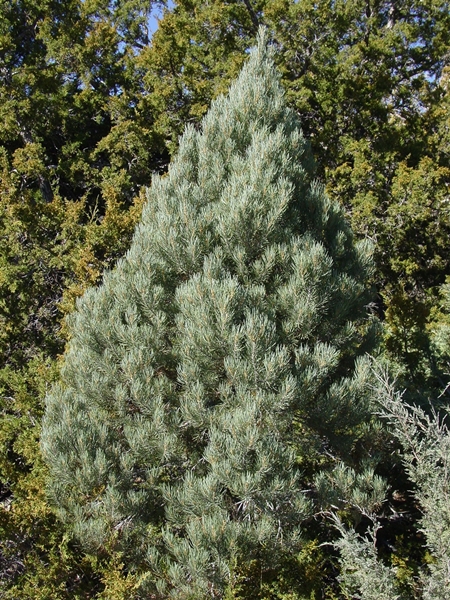by Ken Lain, the mountain gardener

The practice of using living trees over fresh-cut trees to decorate the holidays continues to increase in popularity. Over half of Watters’ local Christmas Tree sales are for living trees that will be planted in January.
Because of their waxy needles and high internal pitch, most conifers need surprisingly little water. This is true for other high-country natives like pine, cypress, cedar, juniper, even spruce. Once these trees reach their mature sizes, they thrive in our arid climate, dry soil, and the extreme range of mountain temperatures.
Don’t have time to view the entire article, see the highlights below:
- Planted evergreens need surprisingly little water.
- Hole size and correct soil amendments are critical to a successful planting.
- The bowl-shaped planting hole bowl should be the same depth and 3 times the width of the root ball being planted.
- Premium mulch per plant should be equal to the size of the root ball.
- The top of the root ball should be able to see sunlight once planted.
- Evergreens are fed with 7-4-4 All Purpose Food for a healthy start.
- Promote deeper roots with ‘Root & Grow‘.
- Top-dress the planting area with a 3-inch layer of shredded cedar bark.
- Water each Christmas tree twice a month through March.
Evergreens do not like to sit in wet, soggy soil because this slows the trees’ internal metabolisms to an almost stasis-like state. Planted in soil that drains appropriately, new root hairs and next spring’s candle buds will form successfully. That is why digging the right size planting hole and adding the correct soil amendments are critical to a successful evergreen planting.
6 steps to planting a living Christmas tree after holiday celebrations:
Step 1 – The bowl-shaped hole should be the same depth as the root ball, but three times as wide. Plants do not need a bottomless pit; they thrive when able to stretch out just under the surface of the soil in search of food and water. This is why a bowl-shaped hole promotes the best root development. Rid the excavated soil of rocks and debris larger than a golf ball.
Step 2 – Improve the planting soil by amending with Watters’ Premium Mulch’. Good mulch will keep clay soils loose and aerated, and help loose granite soil retain water up around the root ball.
The amount of mulch per plant should be equal to the size of the root ball. That is the quantity of mulch needed to blend into the native soil used to fill the hole around each plant.
Step 3 – Evergreen trees are so sensitive to soggy soil that it is recommended planting on a slight mound. Whatever you do, don’t bury the plant; keep the trunk out of the ground. The top of the root ball you see in the grower’s pot should be able to see sunlight once planted.
Step 4 – Evergreens need the right plant food for a healthy start. Use my specially blended 7- 4- 4 “All-Purpose Plant Food” specifically designed for mountain plants. Just sprinkle the granules on top of the root ball and water in thoroughly. The slow-release nutrients promote a deep green color while encouraging thicker root growth with each watering.
Step 5 – Promote deeper roots with ‘Root & Grow‘. Add this liquid rooting hormone to the water used to saturate the root ball. It forces new root hairs to grow, and more roots mean a more vigorous plant. Use this root tonic once per month until new candle growth emerges in spring.
Step 6 – Top-dress the planting area with a 3-inch layer of shredded cedar bark. This layer of nature’s insulation retains moisture, keeps weeds out, and protects from extreme temperature swings. It is like laying a thick blanket over the roots, so they don’t become life-threateningly cold.
Water – Keep the tree moist, but allow it to dry between watering. Give it a thorough soak twice a month through March. Once it begins to develop new growth, bump its water schedule up to twice a week during the first growing season, then once a week after that.

Evergreen of the Month – One tree with a starring role in the mountains of Arizona is enjoying a renewed popularity. It’s the ‘Single Blue Pinyon Pine‘, a local variety whose tidy appearance and unusual blue color give a bold appearance to this rustic tree. It blends well into dry mountain landscapes, with modern settings, or into Mediterranean style gardens. However, its resurgence kicked off at farmers’ markets for its pine nuts! Even young trees produce pine cones with melt-in-your-mouth buttery nuts. It can be grown wild to 10′ or, for that groomed Christmas Tree shape, prune it right after its spring growth.
Until next week, I wish my Christian friends a Merry Christmas, my Jewish friends a Happy Hanukkah, and to my friends celebrating secular joys, Happy Holidays.
Ken Lain can be found throughout the week at Watters Garden Center, 1815 W. Iron Springs Rd in Prescott, or contacted through WattersGardenCenter.com or FB.com/WattersGardenCenter.

